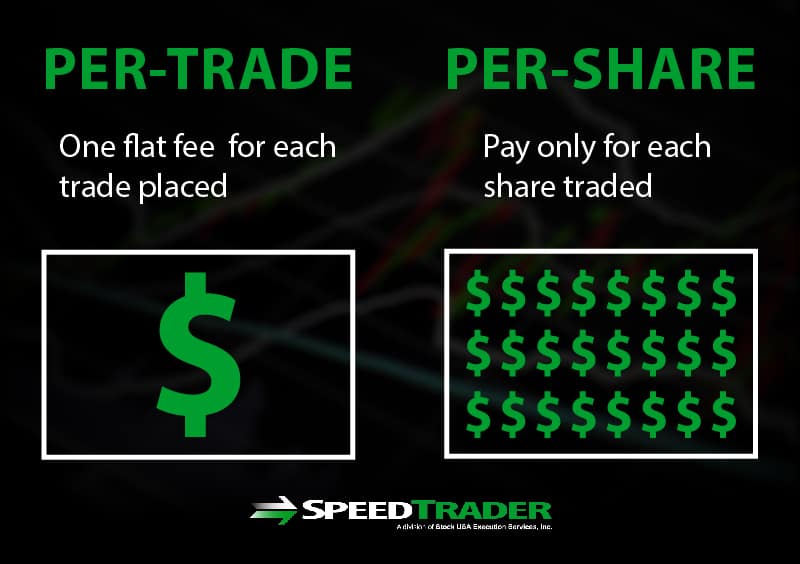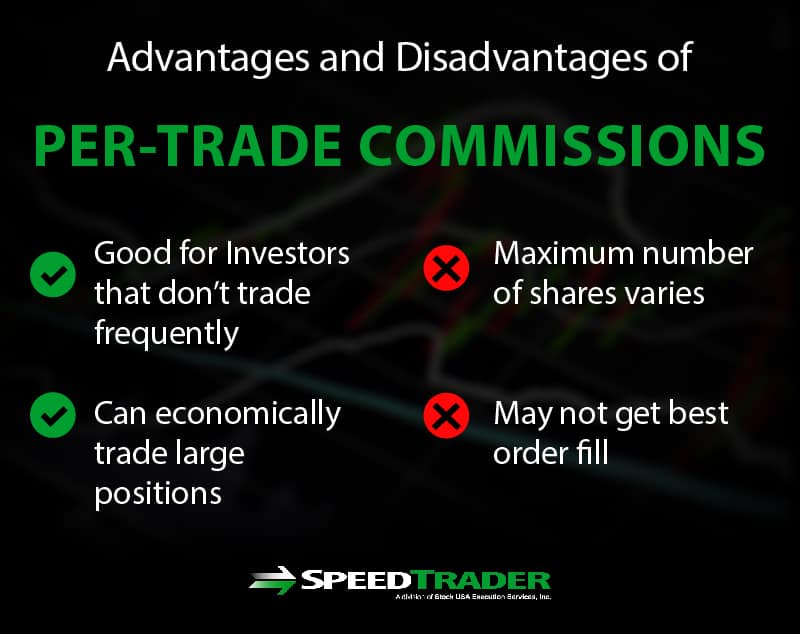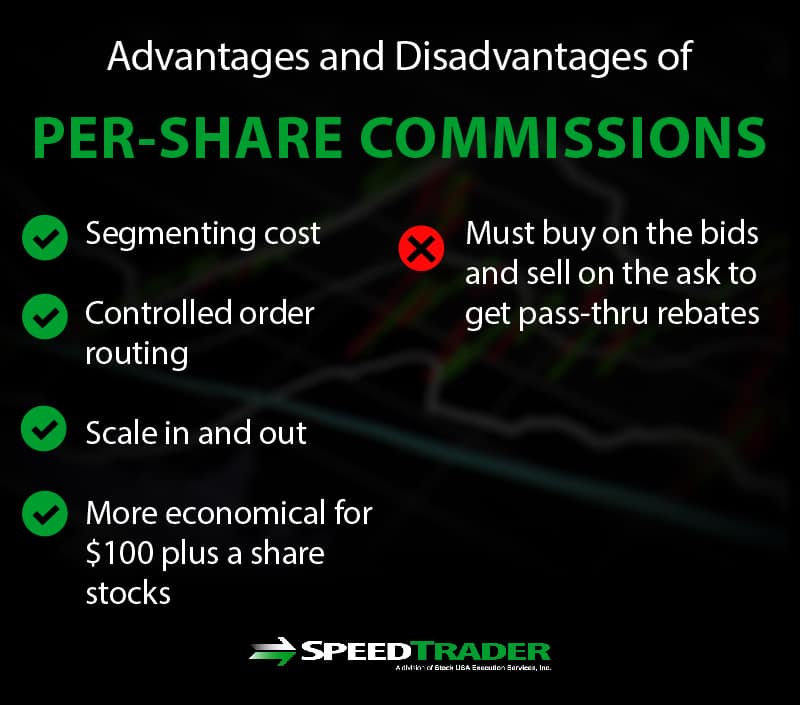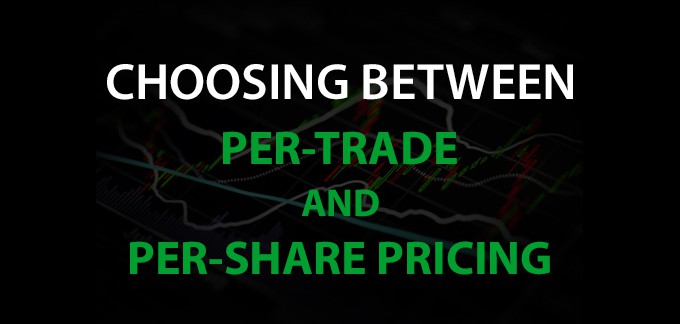Introduction
Commissions are a fixed cost of business when it comes to trading the markets. They are fees paid to the brokerage to execute your trade orders. Commissions can vary between brokers but they usually fall into one of two types of structures; per-trade or per-share pricing. Generally, your style of trading will determine which type is best suited for you. For example, if you were a long-term investor, then a per-trade commission broker would likely be more suitable for you since you wouldn’t be placing too many trades. Per-trade commissions may be fine for medium to long term investors and some swing traders, but active traders usually desire direct access and order routing to enhance their profitability and liquidity. Aside from brokerage commissions, some trades may include regulatory fees such as SEC and FINRA.

Per-Trade Commissions
Brokers that charge a “flat fee” or per-trade commission apply a fixed rate to each trade (i.e. $4.95 per trade). Usually these fees will apply to trades up to 10,000 shares. Some brokers may have different maximum share amounts per trade. This structure works best for investors and swing traders that don’t trade actively intra-day (i.e. 10 or more trades).
Benefits
The best feature of this structure is the ability to buy or sell large position sizes of 5,000 shares or more for a flat rate. A per-share commission of $0.004 would cost $40 on 10,000 shares not including the ECN/exchange pass-thru fees, which could add another $40 for a total of $80 compared to $4.95 flat rate fee. This amounts to a large commission savings proportionate to the size of the trade. However, most per-trade brokers have order flow arrangements with various firms/clearing houses. This means that your order may not get the best fills and liquidity could be a problem. Anytime you place a large block order, you risk being front run by high frequency trading (HFT) programs that step in front of you order causing the price to rise.
Who It’s Good For
The style and type of trades will determine the utility of the underlying commission structure. A per-trade commission makes the most economical sense for larger position trades above 2,000 shares. Penny stock traders that take larger share size positions can benefit the most especially on cheaper priced shares. Of course, these come with a whole different set of problems including liquidity and slippage, not to mention the risk of fraudulent company fundamentals. However, from a commission standpoint, a flat rate fee works great here. It’s always best to check with your broker what the conditions are with small-caps and penny stocks. Investors and swing traders also benefit from per-trade pricing due to the lower trading activity.
The longer a position is held, the more beneficial a flat rate structure is.
Intraday traders or scalpers that trade heavy position sizes may also benefit from the flat rate fees since the sheer volume of total shares make up the savings compared to per-share. However, as mentioned, placing larger sized orders regularly will attract the algos every time and your order fills may be frustratingly awful at times. You may want to break up your order or use hidden size.
Newer traders just getting their “feet wet” in the markets may start off with the per-trade commissions just to get acclimated with placing orders. These traders generally do not have the same routing needs as more experienced traders and the “per-trade” commission can help simplify the process.

Per-Share Commissions
Online direct-access brokers offer per-share commissions often with a sliding scale based on monthly share volume traded. A commission of $0.004 per share means a 1,000 share trade will cost $4 plus ECN/exchange pass-thru fees which can add another $0.002-$0.004 per trade for taking liquidity. However, rebates may also be applied for providing liquidity. Therefore, a trade where you buy 1,000 on the inside bid (providing liquidity) would cost you $4 commission but may result in a $2 ($0.002/share) pass-thru rebate, thereby costing only $2 total. On the flipside, if you were to buy 1,000 on the inside ask price (taking liquidity), it would cost you $6 for the trade. Per-share commissions generally have a minimum order size as well.
Benefits
For more active traders, a per-share commission structure makes more sense not only for segmenting of costs, controlled order routing and ability to scale into and out of positions, but also the additional perks offered by online direct-access brokers. Per share pricing also allows you to play higher priced stocks over $100 more economically, since the smaller shares sizes will result in smaller commissions.
ECN Routing
Direct access mean you can literally point-and-click on the level 2 screen to the ECN or market maker that has the size/liquidity you are seeking to get filled. Having the ability to route your orders directly can save time and costs since you won’t rely on a market maker or clearing firm to determine if it benefits them to fill your order on the inside price or higher. Speed and efficiency are the key benefits of order routing. However, there is another major benefit.
Hidden/Reserve Orders
ECN access also allows you to cloak your order size either through hidden or reserve orders. A hidden order makes your limit order invisible on the on level 1 and level 2 market depth screens. This is done to avoid interrupting the normal “flow” of the underlying stock and attempt to prevent market impact.
A reserve order lets you display a small size while trying to unload a much larger size into the market. For example, you may want to sell 5,000 shares of XYZ, but placing a 5,000 share sell order will cause the algos to step in front of you thereby causing other sellers to hit the bids and inadvertantly caushing the price to fall. This is meant to shake you out by chasing the vanishing liquidity on the bid in a panic. However, if you place a reserve order that displays only 100 shares to sell, rather than 5,000 shares, the buyers will not get spooked and may proceed to take out your shares.
Pre/Post Market Trading
Being able to access ECNs also means you can access pre and post market trading. Granted, this should only be considered by experienced traders. While most stocks are too illiquid with very wide spreads after market hours, there are situations where breaking news like earnings reports will trigger large volume during these times. Trading can only be done through ECNs. Having direct access to the ECNs means you have the ability to trade this action. Depending on your broker, ECNs start trading at 4am EST. and close at 8pm EST. However, liquidity still remains very thin until 8am EST. in the premarket.
Who It’s Good For
The per-share commission structure is best suited for experienced active traders who prefer to scale in and out of positions.
Keep in mind that timing becomes more relevent since it is beneficial to provide as much liquidity as possible in order to get the ECN pass-thru rebates by buying on the bids (into selling pressure) and selling on the asks (into buying pressure). Newer traders can actually end up overpaying if they are constantly buying on the inside ask and selling on the inside bid, thereby taking liquidity both ways. This can end up costing double commissions due to the additional ECN/exchange pass-thru fees. This is why experienced traders with a solid methodology for timing the momentum will benefit the most.

Comparing Per-Trade Versus Per-Share
So which commission pricing structure is best for you? There will always be situations where one may be more advantageous than the other. Let’s take a look at some realistic examples:
EXAMPLE: Buying 10,000-shares
If you are trying to buy 10,000 shares of a stock with a “per-trade” commssion, you may pay a flat rate of $4.95 for the trade. If you try to purchase those same shares with a “per-share” commission, you may $40 to enter the trade (10,000 shares at 0.004/share). On first glance, it may seem like the per-trade commission is a no-brainer, and in some cases it is. However, this simplified example doesn’t account for the actual executions.
For example, if you place a trade with a per-trade order and the stock starts moving above your limit order, you may only get a partial fill. In this case, you either have to increase your limit and pay more for your shares or accept the partial fill and limit your profits. Contrarily, the per-share commission may have allowed you to get a faster execution. It could have also allowed you to hide your size (which may have an impact, depending on the stock’s liquidity).
The point here is simple. There are certain times when saving on commissions may limit your trading profits. The cheaper option isn’t always the better option. While per-trade commissions make sense in a lot of cases, they can also hinder active traders who are looking for better fills and faster executions.
EXAMPLE: Scalping 5,000 shares for $0.03 Profit
Let’s say you want to buy 5,000 shares at 28.27 for a quick scalp at 28.30 for a $0.03 profit. A per-trade/flat rate commission will cost you $4.95 in and $4.95 on the exit for a total of $9.90 commission. A per-share trade commission would cost $20 in and $20 out, assuming no ecn/exchange fees would cost a total of $40, almost 10 times the per-trade commission. This doesn’t include the ECN/exchange pass-thru fees which could add another $30-$40 extra.
EXAMPLE: Scaling In and Out of 500 shares
Let’s say you want to buy 500 shares of XYZ in five 100-share entries in order to capture the best average cost per share and then scale out in three trades. Those eight total trades would cost $39.60 compared to $8 with a per-share commission structure. When comparing straight commission to commission, per-trade commissions work for traders who trade larger position sizes where as per-share commissions are best for traders who like to scale in and out of trades with smaller share increments.

